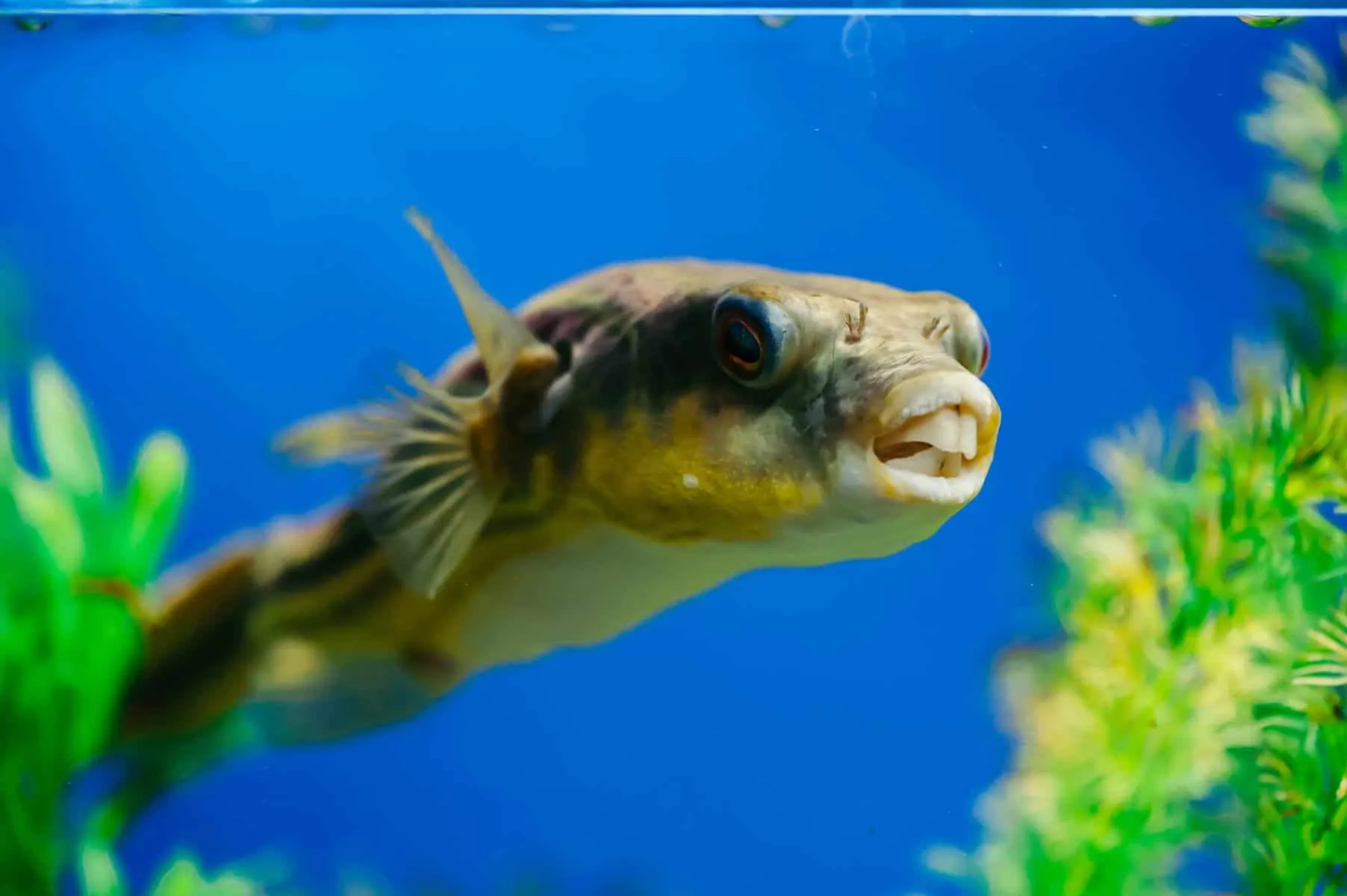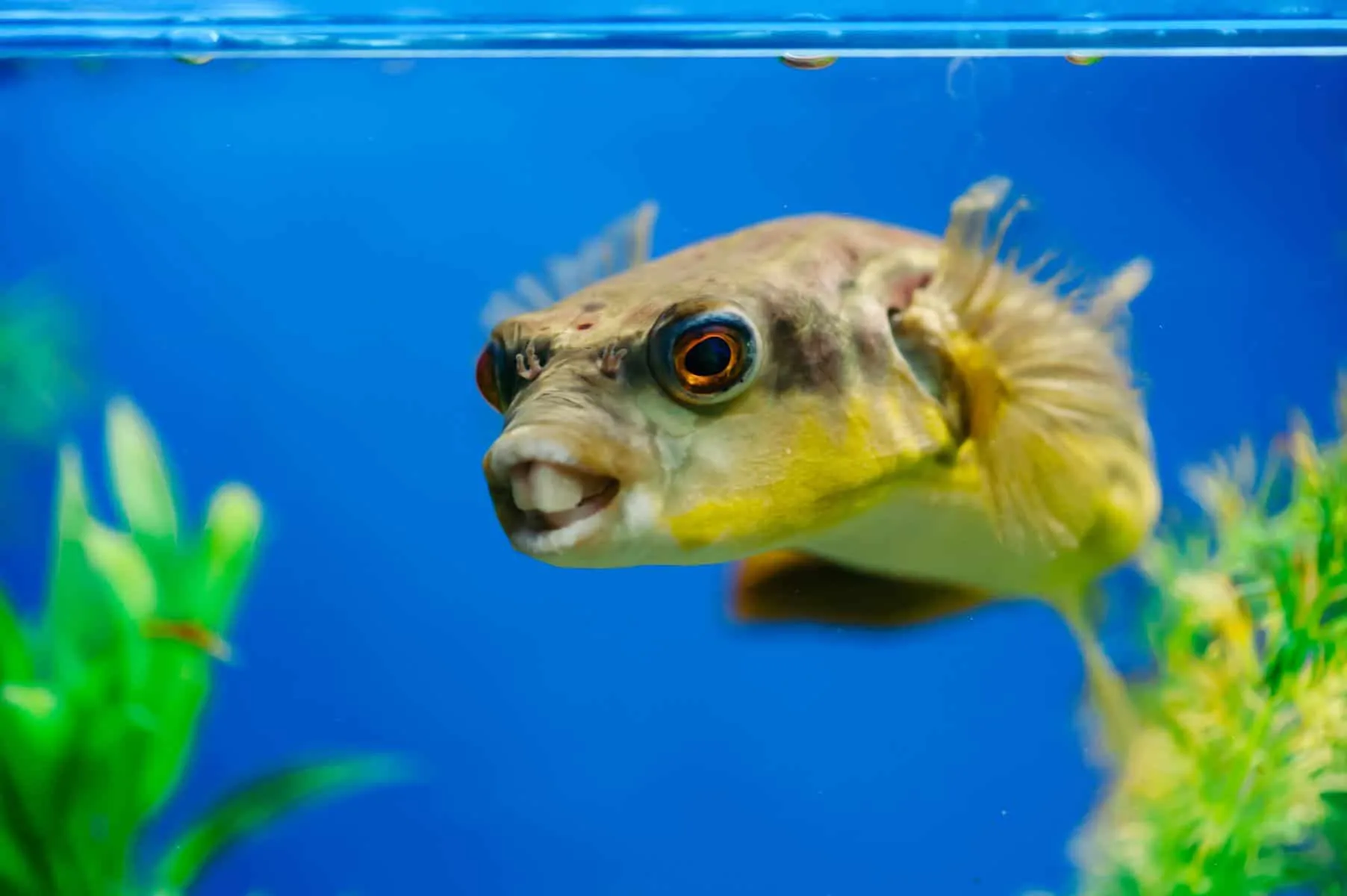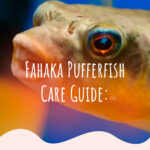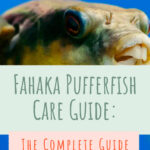The Fahaka pufferfish is an intelligent fish that makes a wonderful pet and can even be taught to take food from your hand. These creatures are one of the cutest in the hobby with their brilliant orange eyes, smiling expression, and strange, bumbling way of swimming, and they are one of the few species of aquarium fish that can truly be regarded as an interactive pet.
However, although friendly and curious around their keepers, these fishes are extremely aggressive toward other fish and invertebrates, so they are only suitable for a single specimen setup.
To find out how to care for the Fahaka pufferfish, check out this detailed guide!

Origins and distribution
The Fahaka pufferfish belongs to the Tetraodontidae family of fishes. The fish has the scientific name Tetraodon lineatus but is known by several common names, including:
- Nile puffer
- Striped puffer
- Band puffer
- Globefish
- Lineatus puffer
The Fahaka puffer was first described way back in 1758 by C. Linnaeus. These fish are found in parts of Africa where they inhabit the large rivers, open waters, densely vegetated areas, and weed beds of the Nile, Niger, Chad Basin, Volta, Geba, Gambia, and Senegal Rivers.
In nature, the carnivorous Fahaka puffer is referred to as a molluscivore, meaning that the fish primarily feeds on oysters, krill, cockles, and mussels.
These fish are solitary in the wild, getting together for breeding purposes only during the spawning season. If two puffers meet other than for breeding purposes, the usual outcome is a fight to the death. That said, the species is not considered to be endangered and doesn’t currently appear on the IUCN Red List.
Appearance

Tetraodon lineatus is an elongated, stocky fish that has startling, bright orange-red eyes and a covering of short spines all over its body.
The fish is grayish-brown on the top, shading to a lighter belly that can be almost white in color. The fish has horizontal banding in light or golden colors extending from the pectoral fins right back across the fish’s tail, hence the puffer’s other common name, Band puffer.
Interestingly, each fish’s coloration and markings vary with the creature’s environment, age, and temperament. Juveniles often have a more mottled coloration, while adults are more intense in color, with the darker areas on the body sometimes appearing a deep red shade.
Boys or girls?
It’s almost impossible to tell the difference between male and female Fahaka puffers. However, females are generally rounder in shape than males, especially when carrying eggs.
Defense mechanisms
These pufferfish can change color, depending on their mood, and they are also able to puff themselves up with air or water if they are threatened.
As the fish inflates, its spines stick out, effectively dissuading predators from attempting to swallow the fish. As a further form of defense, the Fahaka pufferfish can produce toxins in its flesh, making it poisonous if eaten.

How big do Fahaka pufferfish get?
These are extremely large pufferfish that can grow up to 18 inches in length both in nature and in captivity. However, if you don’t have a huge tank and have your heart set on keeping one of these beautiful, enigmatic fish, you could opt to keep a sub-species of these puffers called Tetraodon fahaka rudolfianus. These fish are smaller, growing to just around three inches in length.
How long do Fahaka puffers live?
The average lifespan of these fish is up to ten years, provided they receive the correct diet and are kept in their preferred conditions. That’s pretty long-lived for an aquarium fish, so you’ll get to build up quite a relationship with your pet during that time.
How do you take care of a Fahaka puffer fish?
The Fahaka puffer is pretty straightforward to care for, as long as you provide it with the correct water conditions and dietary requirements.
The main issues with these fish are their aggressive temperament and large size. Also, feeding the fish can be expensive, as they need a diet that consists primarily of human-grade food. It should also be mentioned here that these fish should not be added to a completely new setup if you’re intending on a fishless cycle.
Tank size
These fish can grow to reach 18 inches in length when mature, so you’ll need a tank of at least 125 gallons.
Although puffers aren’t known for their acrobatic skills, it’s recommended that your tank has a cover slide or tightly fitting lid in case the fish jumps out. Puffers swim in all areas of the tank, so the shape is not critical, although a deep, rectangular aquarium provides plenty of swimming space.
Filtration
The Nile puffer produces a considerable amount of waste, and they are messy eaters, too, so you need a powerful canister filter or similar system that turns the tank water over at a rate of at least six to ten times per hour. You’ll need to adjust the flow so that the current isn’t too strong, as these fish aren’t the strongest of swimmers and will become stressed if they are buffeted around by the water.
To keep the water clean and hygienic, you must perform weekly 35 to 50 percent water changes. Remember to spend time deep-cleaning the substrate with an aquarium vacuum system to get rid of fish waste, uneaten food remains, plant debris, and general detritus. You should also pay attention to hotspots where waste accumulates, such as under decorations, in the aquarium corners, and around the base of plants.
Tank decoration
A sandy or fine gravel substrate is the best choice for Fahaka puffers, and smooth stones and driftwood make good decorative items for the tank.
When it comes to planting, although these fish won’t dig up or eat your plants, damage often occurs while the fish are feeding. So, it would be best if you chose robust and hardy plant species for a puffer tank or go down the silk plant route.
Lighting levels in the tank should be normal to moderate.
Water parameters
Although the Fahaka puffer will tolerate a small amount of salinity in the water, these are ostensibly freshwater fishes. These puffers are highly sensitive to ammonia and nitrites in the water, so you should not introduce your puffer to an immature tank that has not been fully cycled.
Fahaka puffers are tropical fish that need a water temperature of 75° F to 82° F.
This pufferfish is highly sensitive to soft water, so the water hardness in your aquarium should be between 10 and 12 dKH with a pH of close to 7.0.
What do Fahaka pufferfish eat?
The Nile puffer is a carnivorous species that are known as molluscivores. In nature, the fishes’ diet includes mollusks, insects, and crustaceans.
In captivity, the fish can be fed snails, crabs, shrimp, and crayfish, and they can sometimes be acclimated to eat freeze-dried krill.
Frequency of feeding
As juveniles, puffers should be fed every other day. When the fish are adults, they only need feeding two to three times per week.
It’s important to feed all pufferfish species some hard-shelled foods to help wear down the fish’s teeth. So, foods like shellfish, snails, and crustaceans are all good. If the fish’s teeth grow too long, the animal won’t be able to eat, and you will have to clip the teeth.
The Fahaka puffer’s diet changes as it matures and grows larger. Juvenile specimens will do well on a diet of krill, frozen foods, and snails. Once over six inches in length, your fish will need lobster, crab legs, clams, mussels, and shrimp. Presoaked jumbo krill are also good food for puffers.
Many people feed their predatory pufferfish small feeder fishes. However, we don’t recommend that you do that, as there is a danger that you might unintentionally introduce parasites and diseases into your aquarium.
Social behavior

Fahaka pufferfish are highly aggressive, and they don’t tolerate other fish in their environment, including members of their own species. For that reason, you must keep one of these bad boys alone.
As these fish are carnivorous and enjoy a diet of crustaceans and the like, it goes without saying that you can’t keep shrimp, crabs, or snails with the Nile puffer.
Although this pufferfish species is antisocial with other fish, they make very friendly, interesting pets. You can expect to form a unique bond with your fish that you don’t get with other species, and you may even be able to train your puffer to take food from your hand.
Breeding and reproduction
In nature, the Fahaka puffer breeds in open water at a depth of up to 50 feet. Also, these fish tend to attack and kill each other on sight. For those reasons, these fish are extremely difficult to breed commercially and in home aquariums.
Spawning
Tetraodon lineatus spawns when the female fish produces an ovipositor. The male fish swims upside down beneath the female, gripping her to connect both the sex organs. Eggs and sperm are released simultaneously to achieve fertilization.
The eggs usually hatch within three to four days in shallow water so that the fry can reach the water surface. Initially, young puffers should be fed infusoria, needing constant feeding to prevent starvation. At two weeks old, the juvenile fish will take brine shrimp.
Like their parents, young puffers are highly aggressive, so separating the youngsters is recommended to prevent injury.
Health and diseases
Fahaka puffers do not have scales or gill covers, and that makes these fish susceptible to many of the common fish diseases that affect tank-kept tropical fish.
Also, Nile puffers are wild-caught, and they can sometimes carry internal parasites. For that reason, you should always check with your supplier or dealer to make sure that the fish you are buying has been treated with a dewormer. If that’s not been done already, treat the fish yourself and keep it in a quarantine tank for at least ten days before adding it to your main display aquarium.
These fish do respond very well to most over-the-counter fish disease treatments. However, you must NEVER use copper in a tank that houses a Fahaka puffer.
Is my Fahaka puffer healthy?
The Nile puffer is a curious, friendly fish that is active by day, swimming around all areas of the tank and coming toward the viewing pane when anyone approaches the aquarium.
If you notice any of the following signs, there may be trouble brewing:
- Poor appetite
- Lethargy and generally appearing disinterested in life
- Swellings, ulcers, and red patches on the skin
- Flicking or rubbing up against tank surfaces, decorations, and the substrate
Common health problems
Ich
Ich is the most common disease that affects the Nile puffer. White Spot disease, as the condition is also known, is caused by a protozoan parasite called Ichthyophthirius multifiliis. Fish with Ich initially begin flicking against objects within the tank. As the parasite’s lifecycle progresses, a rash of tiny white spots appears across the fish’s body, fins, and gills.
Treat Ich by raising the water temperature to 82o F for several days, and treat the water with an appropriate medication that you’ll get in your local fish store.
Flukes
Flukes are parasites that attach themselves to the fish, typically on its body and gills. Fish with flukes rub against solid surfaces within the tank and secrete excessive amounts of mucus.
Treat the aquarium with anti-parasitic medication to kill the flukes.
Fungal infections
Fish with fungal infections develop white cottony growths on their head and body. Quarantine the infected fish, and dose the water with antifungal medication.
Bacterial infections
If the puffer develops reddened patches on its skin or ulcers, a bacterial infection is likely the culprit. Again, quarantine the infected fish, and dose the water with antibacterial medication. Pufferfish are especially susceptible to an infection called Heterobothrium that attacks the fish’s gills.
Availability
Thanks to their aggressive nature, you won’t generally find the Fahaka puffer widely for sale in fish stores, although you can source them online. Prices vary depending on the fish’s age, size, and coloration, typically starting at around $20.
Final thoughts
If you have a very large tank and you’re happy to take on an interesting, friendly fish that has aggressive tendencies, so it must live alone, a Fahaka puffer could be a creature you would like to consider.
These large fish have expensive tastes when it comes to food, and you must be prepared to spend time maintaining and cleaning their tank. However, just seeing that cute, expressive little face gazing lovingly up at you when you say good morning to your pet makes all the effort worthwhile!












